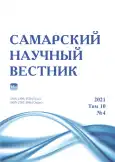Superstitiousness of university students majoring in arts and its role in their professional development
- Authors: Gorodetskaya I.M.1, Khatsrinova O.Y.1, Petrova A.V.1, Abitov I.R.2
-
Affiliations:
- Kazan National Research Technological University
- Kazan (Volga Region) Federal University
- Issue: Vol 10, No 4 (2021)
- Pages: 265-272
- Section: Pedagogical Sciences
- URL: https://journals.rcsi.science/2309-4370/article/view/104930
- DOI: https://doi.org/10.17816/snv2021104305
- ID: 104930
Cite item
Full Text
Abstract
The study addresses peculiarities of superstitiousness and paranormal beliefs of students majoring in Arts (creative type of professions) and its role in their professional development. Superstitiousness is a rather wide-spread phenomenon among different professional groups. Besides there is scientific evidence that students are a socio-demographic group with high level of superstitiousness. There exist two general points of view on superstitiousness as a psychological phenomenon: negative and coping. Creative activity in general and creative professions in particular are characterized by high uncertainty and unpredictability of its outcomes, therefore it was logic to suppose that future creative professionals would be highly superstitious. Besides constant search for innovative solutions and Art itself focuses on irrational aspects of being. Empiric study however showed average and low level of superstitiousness among Arts students, but significant correlations between superstitiousness, paranormal beliefs and personality traits. Differences between various creative professions were also found. The findings may be used for the future studies and applied in the educational practice.
Full Text
##article.viewOnOriginalSite##About the authors
Inna Mikhailovna Gorodetskaya
Kazan National Research Technological University
Email: innamgor@mail.ru
candidate of psychological sciences, associate professor, master student of Design Department
Russian Federation, KazanOlga Yurievna Khatsrinova
Kazan National Research Technological University
Email: khatsrinovao@mail.ru
candidate of technical sciences, associate professor of Engineering Education and Psychology Department
Russian Federation, KazanAnna Vladimirovna Petrova
Kazan National Research Technological University
Email: annavekselman@mail.ru
associate professor of Design Department
Russian Federation, KazanIldar Ravilevich Abitov
Kazan (Volga Region) Federal University
Author for correspondence.
Email: ildar-abitov@yandex.ru
candidate of psychological sciences, associate professor of Clinical Psychology and Psychology of Personality Department
Russian Federation, KazanReferences
- Русинова С.А. Развитие личности специалиста творческих профессий на основе педагогической диагностики // Культура и образование. 2016. № 2 (21). С. 30–39.
- Гнатышина Е.А., Гердт Н.А. Модель формирования профессионально-творческого потенциала студентов творческих профессий // Образование и наука. 2015. № 2 (121). С. 18–27.
- Сурина М.О., Сурин А.А. Особенности подготовки студентов творческих профессий в современном вузе [Электронный ресурс] // Инженерный вестник Дона. 2013. № 4 (27). http://www.ivdon.ru/ru/magazine/archive/n4y2013/2165.
- Николайчук А.С. Современные методы обучения студентов творческих специальностей в системе компетентностного подхода // Территория науки. 2016. № 6. С. 29–33.
- Vyse S.A. Believing in magic: the psychology of superstition. Oxford: Oxford University Press, 2013. 328 p.
- Boyer P. Minds make societies: how cognition explains the world humans create. Yale University Press, 2020. 376 p.
- Boden M. Supernatural beliefs: considered adaptive and associated with psychological benefits // Personality and Individual Differences. 2015. Vol. 86. P. 227–231. doi: 10.1016/j.paid.2015.06.023.
- Irwin H.J. Belief in the paranormal: A review of the empirical literature // The Journal of the American Society for Psychical Research, 1993. Vol. 87. P. 1–38.
- Rudski J.M. The illusion of control, superstitious belief, and optimism // Current Psychology. 2004. Vol. 22. P. 306–315. doi: 10.1007/s12144-004-1036-8.
- Абитов И.Р. Суеверность и ее взаимосвязь с уровнем стресса // Социально-экономические и технические системы: исследование, проектирование, оптимизация. 2016. № 5 (72). С. 10–15.
- Abitov I.R., Gorodetskaya I.M., Akbirova R.R., Sibgatullina L.R. Superstitiousness and paranormal beliefs of engineering students comparing to students majoring in sciences, arts and humanities // Revista Espacios. 2018. Vol. 39, № 10. P. 28–36.
- Измоденова Н.Н. Суеверия как способ жизнедеятельности образованных групп населения // Труды Кольского научного центра РАН. 2013. № 6 (19). С. 20–35.
- Саенко Ю.В. Психологические аспекты изучения суеверий // Вопросы психологии. 2016. № 6. С. 85–97.
- Стоянова И.Я. Пралогические образования в норме и патологии: дис. … д-ра псих. наук. Томск, 2007. 303 с.
- Климов Е.А. Развивающийся человек в мире профессий. Обнинск: Принтер, 1993. 56 с.
- Абитов И.Р., Акбирова Р.Р. Разработка опросника суеверности [Электронный ресурс] // Психологические исследования. 2021. Т. 14, № 75. http://psystudy.ru/index.php/num/2021v14n75/1858-abitov75.html.
- Григорьев Д.С. Адаптация и валидизация шкалы веры в паранормальное Дж. Тобасика // Социальная психология и общество. 2015. Т. 6, № 2. С. 132–145.
- Егорова М.С., Паршикова О.В. Психометрические характеристики Короткого портретного опросника Большой пятерки (Б5-10) [Электронный ресурс] // Психологические исследования. 2016. Т. 9, № 45. http://psystudy.ru/index.php/num/2016v9n45/1239-egorova45.html.
- Серавин А.И. Исследование творчества. СПб.: Копи-Парк, 2005. 200 с.
- Седых А.Б. Вклад Джона Льюиса Холланда в психологию профессий и карьеры (к 90-летию со дня рождения известного ученого) // Человек. Сообщество. Управление. 2019. № 4. С. 54–67.
- Выготский Л.С. Психология искусства. М.: Азбука, 2021. 448 с.
- Marques N.S., Benvenuti M.F.L. The study of superstition in behavioral sciences: discussing experimental arrangements and theoretical assumptions // Trends in Psychology. 2017. Vol. 25, № 3. P. 1397–1409. doi: 10.9788/TP2017.
- Womack M. Why athletes need ritual: A study of magic among professional athletes // Sport and Religion / S.J. Hoffman (ed.). Champaign: Human Kinetics, 1992. P. 191–202.
- Taylor S.E. Adjustment to threatening events: a theory of cognitive adaptation // American Psychologist. 1983. Vol. 38, № 1. P. 1161–1173. doi: 10.1037/0003-066X.38.11.1161.
Supplementary files






